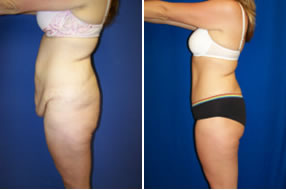Dr. Pousti
Plastic Surgery After Weight Loss
| Dr. Tom Pousti, Cosmetic Surgeon | ||
| Pousti Plastic Surgery | ||
| (619) 466-8851 | ||
| PoustiPlasticSurgery.com |
With massive weight loss in a short period of time, patients are sometimes left with a significant amount of excess skin. In severe cases, this can lead to problems with moisture, skin break down, hygiene and body image problems (aesthetic concerns). This excess skin remains a reminder of the person’s past problem with obesity and limits the patient’s satisfaction with the weight loss he/she has achieved. Although patients are often very pleased with the improvement in their medical issues (such as diabetes and high blood pressure) achieved after weight loss, some feel that they need to undergo skin removal in order to fully achieve their goal. Plastic surgical procedures after weight loss can help the patient achieve their goals and significantly improve their self-image. It is important to work with a plastic surgeon with extensive experience due to the fact that treatment of the post-bariatric surgery patient is unique in that the patient’s skin elasticity may be permanently decreased. Dr. Pousti has helped many patients in this situation.

As patients lose weight, their self-image and sense of well-being improves, and many spend more time tending to cosmetics, pedicures, manicures, hair styling and coloring, etc. Some even opt for the facelift that they considered for years, but never made a priority.Face and neck lifting surgery help eliminate loose skin and the underlying muscle and fatty tissue. The re-suspension of the tissues helps rejuvenate the face and neck area.

Many female patients describe some loss of breast tissue after weight loss of any kind. This comes as a welcome change for most, as it decreases debilitating back and shoulder pain. As the patient enjoys more and more compliments from friends and family regarding their overall appearance and vitality, they sometimes feel that a breast augmentation is “the frosting on the cake.” Breast augmentation (saline or silicone gel breast implants) along with breast lifting (mastopexy) work together to achieve the desired cosmetic appearance in cases of severe loss of breast tissue. The mastopexy operation serves to raise the nipple-areola complexes higher on the chest wall (by removing redundant or loose skin) while the breast augmentation serves to increase fullness of the breasts especially along the superior pole of the breasts.
Saline Implants
Saline implants have a silicone rubber shell that is inflated to the desired size with sterile saline. The implants are placed under the pectoralis muscle deflated and therefore, the incision used for this type of implant is minimal. These implants can be overfilled to achieve a more rounded appearance.
Saline implants have some advantages over silicone implants. Silicone implant ruptures are harder to detect. When saline implants rupture, they deflate and the results are seen almost immediately. When silicone implants rupture, the breast often looks and feels the same because the silicone gel may leak into surrounding areas of the breast without a visible difference. Patients may need an MRI to diagnose a silicone gel rupture. Saline implants are also less expensive than the silicone gel implants.
Silicone Implants
Silicone implants have a silicone rubber shell that is filled with a fixed amount of silicone gel. Most silicone gel-filled implants are not adjustable and therefore, the incision used to place the silicone gel implant is larger than the incision needed for saline implants. The silicone gel implant cannot be overfilled – it comes in an exact size that cannot be manipulated.
Silicone implants vary in shell surface (smooth/textured), shape, profile, volume, shell thickness, and number of shell lumens.
Some surgeons feel that silicone implants have a more natural look and feel than saline implants because silicone gel has a texture that is similar to breast tissue. Each patient differs in the amount of breast tissue that they have. If a patient has enough breast tissue to cover the implant, the final result will be similar when comparing saline implants versus silicone gel implants. If a patient has very low body fat and/or very little breast tissue, the silicone gel implants may provide a more natural result.
As of 2006, the FDA has approved the use of silicone gel implants manufactured by the Mentor Corporation and Allergan (formerly McGhan) for breast augmentation surgery.
If a patient has skin on their abdomen that doesn’t shrink as much as they wanted, they may develop a heat-rash with strenuous exercise. Abdominoplasty (tummy tuck) surgery serves to remove the excess skin of the abdomen while tightening up the abdominal wall muscles. This operation serves to improve the contour of the abdominal wall while the patient is standing, leaning over and sitting down. At the same time, the pubic area may be reduced and “lifted”. If the pubic area is not addressed during the abdominoplasty procedure, the patient often will be dissatisfied with the end result of surgery.

If patients complain of excess skin circumferentially at the level of the abdomen and lower back, lower body lifting and belt lipectomy procedures serve to remove redundant skin of the abdomen and back circumferentially – this operation serves to improve the contour of the buttocks, hips, thighs and abdomen.
Weight loss can leave loose or “hanging” skin of the upper arm, between the elbow and shoulder. This area is addressed using the brachioplasty or arm lifting surgery. One of the keys of this operation is to plan the resulting scar to fall at the lower edge of the arm so that the scar is not visible from the front or back view. This operation may be extended to address the excess skin of the upper chest as well (upper body lift).
If patients complain of extra skin of the thighs, this area can be treated using the thigh lifting techniques. A medial thigh lift will address the inner thighs while the lower body lift addresses the outer part of the thighs.
When considering any type of plastic surgery, choosing your surgeon is one the most important decisions a patient makes. An astute patient will evaluate the doctor’s credentials, training, specific board certification and experience. Before and after procedures, meeting with previous patients and reading patient testimonials may be useful. Connection with the plastic surgeon is critical to individualize each patient’s case. Safety is of primary concern and factors such as medical problems, age, exercise tolerance and length of surgery are some of the factors considered during the consultation. Care must be taken not to attempt too much surgery simultaneously as this may result in complications. During the office visits, the surgeon will get to know more about the patient’s health history as well as expectations and goals. Patients are educated regarding the procedure, post-operative care and especially potential limitations and/or possible risks and complications of any planned procedure.
Dr. Pousti is well qualified to assist patients after massive weight loss. He is board certified in General Surgery as well as Plastic Surgery and has been trained at some of the finest institutions in the United States. He has been in private practice for over 12 years and has had the privilege of helping thousands of patients reaching their goals after significant weight loss.


